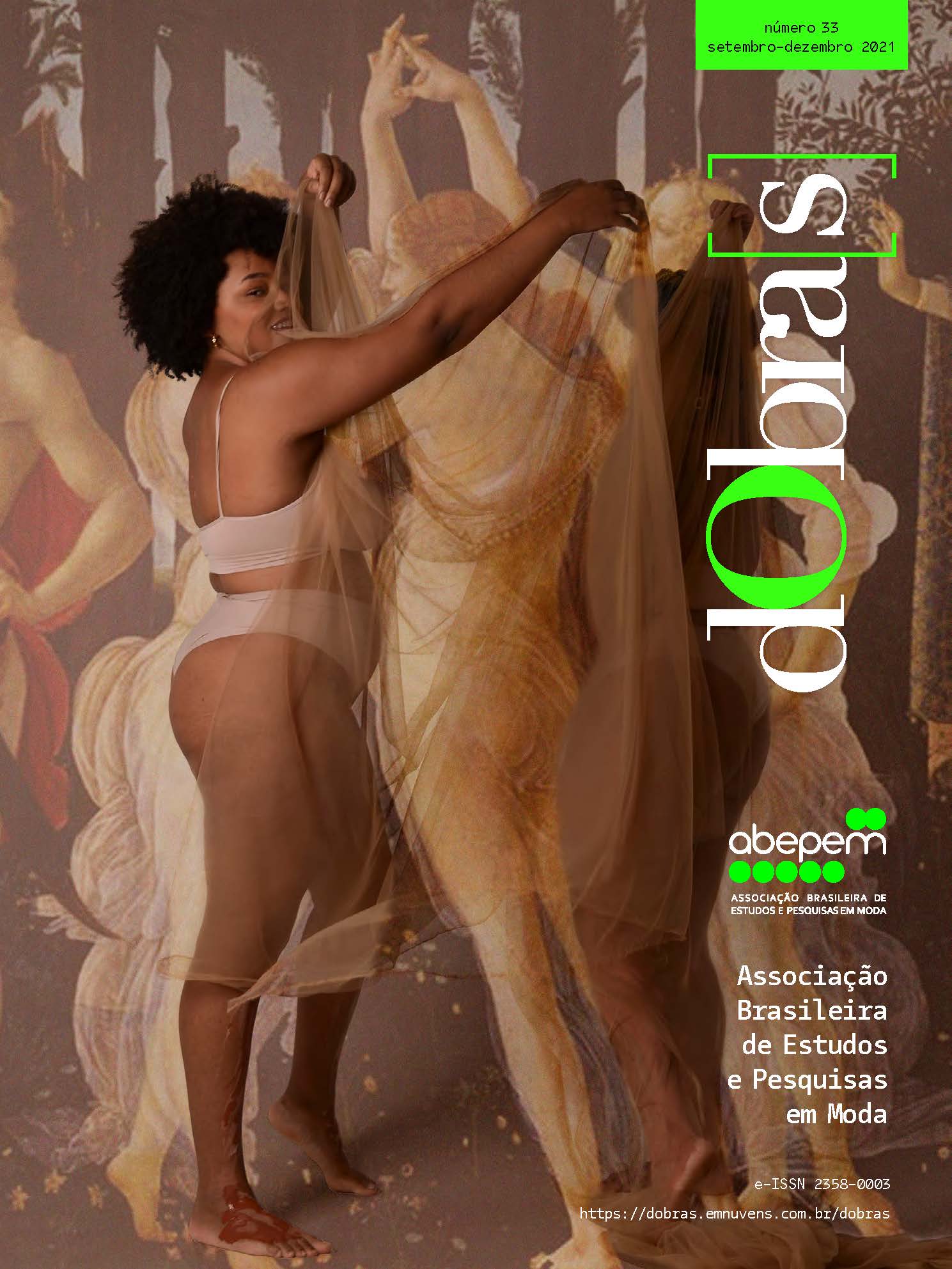Adaptações de conforto para o vestuário de mulheres idosas de tamanho grande
DOI:
https://doi.org/10.26563/dobras.i33.1435Palabras clave:
Adaptações de conforto, Corpo tamanho grande, Mulher idosa, Vestuário inclusivoResumen
Este trabalho tem uma relação direta com a temática da pesquisa de Doutoramento sobre “Adequação do Vestuário da Idosa Dependente de Cuidados, Considerando a sua Modificação Anatômica”, realizada em 2017 na Universidade do Minho, em Portugal. O estudo tem como objetivo apresentar sugestões adaptáveis ao vestuário, destacando as características do conforto para adequação às condições físicas e posturais da mulher idosa de tamanho grande. O termo “tamanho grande” é usado neste artigo como referência aos corpos de mulheres idosas que apresentam sobrepeso ou obesidade, de acordo com a classificação médica. Foram observados a postura, o movimento e o tempo de permanência na posição sentada da idosa de tamanho grande. Tais observações poderão contribuir de forma significativa para as sugestões de materiais e de adaptações do vestuário, ponderando as características do conforto sensorial, termofisiológico, psicológico e, mais especificamente, ergonômico. A pesquisa é de natureza descritiva e qualitativa, com levantamentos conceituais, destacando Hoff, 2016; Li, 2001; Saltzman, 2004; Aldrich, 2015; Gill, 2011; Romeo, 2013; Aires, 2019, entre outros, que reforçam o estudo com as sugestões de materiais, de métodos e de técnicas que promovam o conforto do produto, com destaque para a relevância do assunto no momento atual.
Descargas
Citas
AIRES, Aliana. B. De gorda a plus size: a moda de tamanho grande. Barueri, SP: Estação das Letras e Cores, 2019. 224 p.
ALDRICH, Winifred. Metric pattern cutting for women’s wear. Blackwell Pub, 2015.
ASHDOWN, Susan et. al. Improved apparel sizing: Fit and Anthropometric 3D Scan Data. National Textile Center Research Briefs. 2005. Disponível em: http://www.human.cornell.edu/fsad/research/upload/S04-CR01-07.pdf.
ANITA, S. et al. A study of the antimicrobial property of encapsulated copper oxide nanoparticles on cotton fabric, Textile Research Journal, 81(10), 2011, pp. 1081–1088. Doi: 10.1177/0040517510397577.
BOH, Bojana; ŠUMIGA, Boštjan. Microencapsulation technology and its applications in building construction materials, RMZ – Materials and Geoenvironment, 2008, 55(3), pp. 329–344. Disponível em: http://www.rmz-mg.com/letniki/rmz55/RMZ55_0329-0344.pdf.
CALLAGHAN, Jack P.; DUNK, Nadine M. Examination of the flexion relaxation phenomenon in erector spinae muscles during short duration slumped sitting. Clinical biomechanics (Bristol, Avon), 17(5), pp. 353–60, 2002. Disponível em: http://www.ncbi.nlm.nih.gov/pubmed/12084539.
CALDAS, Artemísia. L. Adequação do vestuário para idosas dependentes de cuidados, considerando a sua modificação anatômica. Universidade do Minho-Portugal. 2017. Tese de Doutoramento. Disponível em: https://core.ac.uk/download/pdf/154274187.pdf.
CHUMLEA, W. Cameron; BAUMGARTNER, Richard N. Status of anthropometry and body composition data in elderly subjects, The American journal of clinical nutrition. American Society for Nutrition, 50(5 Suppl), 1989, pp. 1158-66–5. Disponível em: http://www.ncbi. nlm.nih.gov/pubmed/2683724.
ESTEVES, Dayane Barros; FERNANDEZ, Juan Carlos Aneiros. (2017). Velhice, corpo e saúde. Revista Kairós-Gerontologia, 20(4), 383-401. ISSN e 2176-901X. São Paulo (SP), Brasil: FACHS/NEPE/PEPGG/PUC-SP. Disponível em: https://revistas.pucsp.br/kairos/article/view/40563. Acesso em: 24 jun. 2021.
GILL, Simeon. Improving garment fit and function through ease quantification. Journal of Fashion Marketing and Management: An International Journal. Emerald Group Publishing Limited, 2011,15(2), pp. 228–241. Doi: 10.1108/13612021111132654.
HUGHES, Kimberly A. et al. A test of evolutionary theories of aging, Proceedings of the National Academy of Sciences of the United States of America. National Academy of Sciences, 2002, 99(22), pp. 14286–91. Doi: 10.1073/pnas.222326199.
HERNÁNDEZ, Nina. Tailoring the unique figure. Göteborg University. 2000. Disponível em: http://hdl.handle.net/2077/32796.
HOFFMAN, Michael E. Bases biológicas do envelhecimento, Revista Idade Ativa. Campinas, SP. 2003.
HOFF, Tânia. Comunicação publicitária: dos regimes de visibilidade do corpo diferente às biossociabilidades do consumo. In: Corpos discussivos: dos regimes de visibilidade às biossociabilidades do consumo. Tânia Hoff (Org.). Recife: Editora UEPE, 2016.
IBGE - Instituto Brasileiro de Geografia e Estatística. A divulgação do Atlas do Censo Demográfico 2010. Disponível em https: //censo2010.ibge.gov.br/noticias-censo.html?busca=1&id=1&idnoticia=2965&t=pns-2013-dois-anos-mais-metade-nascimentos-ocorreramcesariana& view=noticia. Acesso em 22/03/2021.
IIDA, Itiro. Ergonomia: projeto e produção. 2a. Editado por E. Blucher. São paulo, 2005. LI, Yi. The science of clothing comfort. Textile Progress, 2001. 31(1–2), pp. 1–135. doi: 10.1080/00405160108688951.
MEINANDER, Harriet; VARHEENMAA, Minna. Clothing and textiles for disabled and elderly people, VTT TIEDOTTEITA – RESEARCH NOTES 2143 Clothing. Finland: JULKAISIJA – UTGIVARE – PUBLISHER. 2002. Disponível em: http://www.vtt.fi/inf/pdf/ tiedotteet/2002/T2143.pdf.
MORO, Antonio Renato P. Análise biomecánica da postura sentada: uma abordagem ergonômica do mobiliário escolar. Universidade Federal de Santa Maria (RS), 2000. Minayo, Maria Cecília de Souza. O desafio do conhecimento: pesquisa qualitativa em saúde. Rio deJaneiro: Abrasco. 2007.
MINISTÉRIO DA SAÚDE. BRASIL. Orientações para coleta e análise de dados antropométricos em serviços de saúde: norma técnica do sistema de Vigilância Alimentar e Nutricional - SISVAN. Editado por Ministério da Saúde. 2011. Disponível em: http:// dab.saude.gov.br/portaldab/biblioteca.php?conteudo=publicacoes/orientacoes_coleta_analise_dados_antropometricos.
OLIVEIRA, Bruno Jorge C. de. Alterações lipidémicas e da composição corporal induzidas pelo exercício físico em jejum. Estudo com idosos. Faculdade de Desporto da Universidade do Porto. 2013. Disponível em: http://hdl.handle.net/10216/70654.
O’SULLIVAN, Peter B.et al. Effect of different upright sitting postures on spinal-pelvic curvature and trunk muscle activation in a pain-free population, Spine, 2006, 31(19), pp. E707–E712. Doi: 10.1097/01.brs.0000234735.98075.50.
PYNT, Jenny; HIGGS, Joy; MACKEY, Martin. Seeking the optimal posture of the seated lumbar spine, Physiotherapy Theory and Practice. Taylor & Francis, 2001. 17(1), pp. 5–21. Doi: 10.1080/09593980151143228.
ROMEO, Laurel D. Exploration of plus-size female teens’ apparel fit and sizing in the United States. Graduate Theses and Dissertations. Iowa State University, 2013. Disponível em: http://lib.dr.iastate.edu/etd/13490.
SALTZMAN, Andrea. El cuerpo diseñado: sobre la forma en el proyecto de la vestimenta. Buenos Aires: Paidós. 2004.
SLATER, Keith. Human comfort. Charles Thomas Pub. Ltda.1985.
TWIGG, Julia. Clothing, age and the body: a critical review, Ageing and Society. Cambridge University Press, 2007, 27(2), pp. 285–305. Doi: 10.1017/S0144686X06005794.
ZHANG, Lijian. A multi-dimensional approach for sitting comfort assessment. Dissertation submitted to the Department of Industrial Engineering Program and the Faculty of the Graduate School of the State University of New York at Buffalo. State University of New York.1992.
Descargas
Publicado
Cómo citar
Número
Sección
Licencia

Esta obra está bajo una licencia internacional Creative Commons Atribución-NoComercial-CompartirIgual 4.0.
Direitos Autorais para artigos publicados nesta revista são do autor, com direitos de primeira publicação para a revista. Em virtude de aparecerem nesta revista de acesso público, os artigos são de uso gratuito, com atribuições próprias, em aplicações educacionais e não-comerciais









